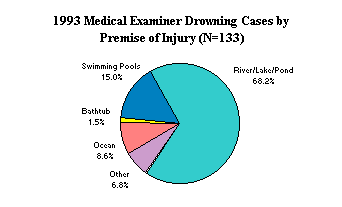
N.C. OCME Annual Report 1993
Back to Annual Report Index | Appendix
Chapter 7: Non-Motor Vehicle Accidents
There were 1,098 non-motor vehicle accidental deaths investigated by the Medical Examiner System in 1993. Figure 26 shows that fires, falls, and drownings represent a little more than half (52%) of these deaths. Figure 27 exhibits percentages of alcohol use for each type of accident. Alcohol played a role for many deaths, particularly for fire and drowning deaths.
Figure 26
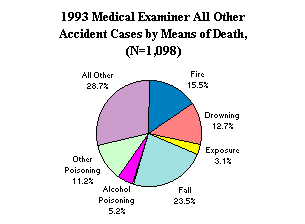
Figure 27
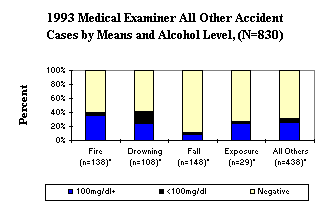
*Total tested for alcohol
Fire
There were 164 accidental fire deaths in North Carolina in 1993. Nonwhite males had the highest death rate and nonwhites in general had double the death rate compared to whites. Fire death rates by age exhibit a U-shaped pattern in which the very young and the very old had the highest rates (Figure 28). The highest frequency of fire deaths was in the winter months.
Figure 28
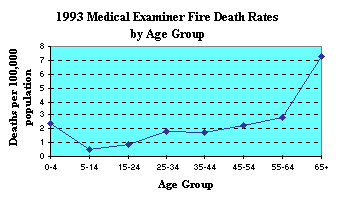
Table 11: 1993 Medical Examiner Fire Death Rates by Race and Sex (per 100,000 population)
| White | Nonwhite | Total | |
|---|---|---|---|
| Male | 2.4 | 6.0 | 3.2 |
| Female | 1.3 | 2.2 | 1.6 |
| Total | 1.8 | 3.4 | 2.4 |
Figure 29 exhibits fire deaths by cause of death. Approximately 87 percent of all fire deaths were in a housefire, and the majority of those deaths were attributed to smoke inhalation.
Figure 29
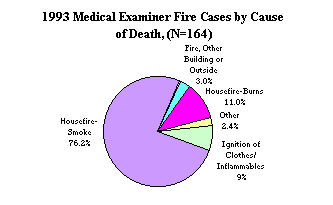
Falls
There were 247 accidental deaths due to falls in 1993. The death rates were the highest for white males (Table 12). Death rates by age group show an increase with advancing age. Many deaths due to falls occur among elderly individuals who die of complications following a fall that fractures a leg or hip and in whom serious underlying natural disease also play a role. Death due to falls among the elderly are underreported to the Medical Examiner System, a fact which is reflected in the higher death rate in the 65+ age group in vital statistics data (Figure 30).
[Figure 30 is unavailable.]
Table 12: 1993 Medical Examiner Fall Death Rates by Race and Sex (per 100,000 population)
| White | Nonwhite | Total | |
|---|---|---|---|
| Male | 4.3 | 4.1 | 4.2 |
| Female | 3.3 | 1.7 | 2.9 |
| Total | 3.8 | 2.8 | 3.6 |
Figure 31 shows fall deaths by nature of fall.
Figure 31
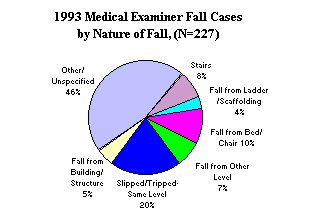
Drownings
There were 133 accidental drowning deaths in 1993. Nonwhite males had the highest death rate and males had a death rate almost seven times that of females (Table 13). The age groups 0-4, 15-24, and 35-44 had the highest age-specific death rates (Figure 32). Drowning deaths occurred more frequently in the summer months (May through September).
Figure 32
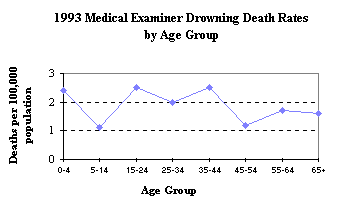
Table 13: 1993 Medical Examiner Drowning Death Rates by Race and Sex (per 100,000 population)
| White | Nonwhite | Total | |
|---|---|---|---|
| Male | 2.8 | 5.6 | 3.4 |
| Female | 0.5 | 0.3 | 0.5 |
| Total | 1.6 | 2.8 | 1.9 |
Figure 33 exhibits drowning deaths by premise of injury. The majority of drownings occur in rivers or lakes. Other studies at the Office of the Chief Medical Examiner have shown that farm pond drownings are especially prevalent in North Carolina.
Figure 33
